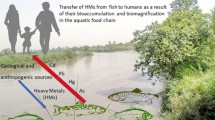Abstract
The level of mercury, iron, copper, and zinc was measured in 18 Great cormorants (Phalacrocorax carbo) collected from Anzali and Gomishan wetlands in the south of the Caspian Sea. The mean level of metals in dried tissues of the muscle, liver, and kidney was 2.26, 5.71, 3.79—Hg; 943.54, 379.97, 348.05—Fe; 42.64, 14.78, 60.79—Cu, and 71.97, 134.63, 77.82—Zn, respectively (mg/kg). There was no significant different between genders in terms of accumulation of metals, except for copper in the kidney. The results of Pearson correlation showed a positive and strong relationship between the fat in the liver and mercury (r = 0.95, R2 = 0.90). Also, there was a significant difference between the values of all metals with the allowable limits presented in EPA, WHO, and CCME, where all of values were above standard levels. Thus, as the muscles of the bird are sometimes eaten by humans, this result is a serious warning. Nevertheless, the relatively high levels of heavy metals accumulated in different tissues of Great cormorant at that time are a result of their high weight and nourishment they have at the terminal days of their migration due to lack of natural physical activity. Regarding to the importance of heavy metals in birds, we suggest the same study to be conducted on the species in other seasons and wetlands.


Similar content being viewed by others
References
Aazami, J., Esmaili-Sari, A., Bahramifar, N., Ghasempouri, M., & Savabieasfahani, M. (2011). Mercury in liver, kidney, feather and muscle of seabirds from major wetlands of the Caspian Sea, Iran. [journal article]. Bulletin of Environmental Contamination and Toxicology, 86(6), 657–661. https://doi.org/10.1007/s00128-011-0271-6.
Aazami, J., Esmaili-Saria, A., Bahramifar, N., & Savabieasfahani, M. (2012). Total and organic mercury in liver, kidney and muscle of waterbirds from wetlands of the Caspian Sea, Iran. Bulletin of Environmental Contamination and Toxicology, 89(1), 96–101. https://doi.org/10.1007/s00128-012-0653-4.
Azadeh, K., & Yazdandad, D. H. (2008). A study in the concentration of heavy metals in some organs of great cormorant (phalacrocorax carbo). Journal in Environmental Studies, 33(43), 10–18 (in Persian).
Bozkurt, M., Cabuk, M., & Alcicek, A. (2008). Effect of dietary fat type on broiler breeder performance and hatching egg characteristics. Journal of Applied Poultry Research, 17(1), 47–53. https://doi.org/10.3382/japr.2007-00008.
Degernes, L. A. (2008). Waterfowl toxicology: a review. Veterinary Clinics of North America: Exotic Animal Practice, 11(2), 283–300. https://doi.org/10.1016/j.cvex.2007.12.001.
Dmowski, K. (1999). Birds as bioindicators of heavy metal pollution: review and examples concerning European species. Acta Ornithologica-Polska Akademia Nauk-Original Edition, 34, 1–26.
EPA, U. (2014). Risk-based concentration table. Philadelphia PA, United States. Washington DC: Environmental Protection Agency.
Ferrer, E., Santoni, E., Vittori, S., Font, G., Mañes, J., & Sagratini, G. (2011). Simultaneous determination of bisphenol A, octylphenol, and nonylphenol by pressurised liquid extraction and liquid chromatography–tandem mass spectrometry in powdered milk and infant formulas. Food Chemistry, 126(1), 360–367. https://doi.org/10.1016/j.foodchem.2010.10.098.
Freeman III, A. M., Herriges, J. A., & Kling, C. L. (2014). The measurement of environmental and resource values: theory and methods (3rd Edition, p. 437). Abingdon: Routledge Publisher.
Furness, R., & Greenwood, J. J. (Eds.). (2013). Birds as monitors of environmental change. Dordrecht: Springer Science & Business Media.
Heidari, B., Bakhtiari, A. R., & Shirneshan, G. (2013). Concentrations of Cd, Cu, Pb and Zn in soft tissue of oyster (Saccostrea cucullata) collected from the Lengeh Port coast, Persian Gulf, Iran: a comparison with the permissible limits for public health. Food Chemistry, 141(3), 3014–3019. https://doi.org/10.1016/j.foodchem.2013.06.002.
Hod, E., & Spitalnik, S. (2012). Stored red blood cell transfusions: Iron, inflammation, immunity, and infection. Transfusion Clinique et Biologique, 19(3), 84–89. https://doi.org/10.1016/j.tracli.2012.04.001.
Horai, S., Watanabe, I., Takada, H., Iwamizu, Y., Hayashi, T., Tanabe, S., & Kuno, K. (2007). Trace element accumulations in 13 avian species collected from the Kanto area, Japan. Science of the Total Environment, 373(2), 512–525. https://doi.org/10.1016/j.scitotenv.2006.10.010.
Houserová, P., Kubáň, V., Kráčmar, S., & Sitko, J. (2007). Total mercury and mercury species in birds and fish in an aquatic ecosystem in the Czech Republic. Environmental Pollution, 145(1), 185–194. https://doi.org/10.1016/j.envpol.2006.03.027.
Koivula, M. J., & Eeva, T. (2010). Metal-related oxidative stress in birds. Environmental Pollution, 158(7), 2359–2370. https://doi.org/10.1016/j.envpol.2010.03.013.
Lewis, S., Becker, P., & Furness, R. (1993). Mercury levels in eggs, tissues, and feathers of herring gulls Larus argentatus from the German Wadden Sea Coast. Environmental Pollution, 80(3), 293–299. https://doi.org/10.1016/0269-7491(93)90051-O.
Maffucci, F., Caurant, F., Bustamante, P., & Bentivegna, F. (2005). Trace element (Cd, Cu, Hg, Se, Zn) accumulation and tissue distribution in loggerhead turtles (Caretta caretta) from the Western Mediterranean Sea (southern Italy). Chemosphere, 58(5), 535–542. https://doi.org/10.1016/j.chemosphere.2004.09.032.
Mazloomi, S., Esmaeili, A., Ghasempoori, S. M., & Omidi, A. (2008). Mercury distribution in liver, kidney, muscle and feathers of Caspian Sea common cormorant (Phalacrocorax Carbo). Research Journal of Environmental Sciences, 2(6), 433–437. https://doi.org/10.3923/rjes.2008.433.437.
Mollazadeh, N., Esmaili, A., & Ghasempouri, M. (2011). Distribution of mercury in some organs of Anzali wetland common cormorant (Phalacrocorax carbo). In 2nd International Conference on Environmental Engineering and Applications, IPCBEE (Vol. 17). Singapore: IACSIT Press.
Nam, D. H., Anan, Y., Ikemoto, T., Okabe, Y., Kim, E. Y., Subramanian, A., Saeki, K., & Tanabe, S. (2005a). Specific accumulation of 20 trace elements in great cormorants (Phalacrocorax carbo) from Japan. Environmental Pollution, 134(3), 503–514. https://doi.org/10.1016/j.envpol.2004.09.003.
Nam, D.-H., Anan, Y., Ikemoto, T., & Tanabe, S. (2005b). Multielemental accumulation and its intracellular distribution in tissues of some aquatic birds. Marine Pollution Bulletin, 50(11), 1347–1362. https://doi.org/10.1016/j.marpolbul.2005.05.004.
Namroodi, S., Farmani, M., & Rezaei, H. (2017). A survey on heavy metal bioaccumulation in tissues of wild and rural geese in Golestan Province, Iran. Journal of Mazandaran University of Medical Sciences, 27(147), 409–414.
Ofukany, A. F., Hobson, K. A., & Wassenaar, L. I. (2012). Connecting breeding and wintering habitats of migratory piscivorous birds: implications for tracking contaminants (Hg) using multiple stable isotopes. Environmental Science & Technology, 46(6), 3263–3272. https://doi.org/10.1021/es204135s.
Rahimi, R., Monavari, S., Karami, M., Shariat, M., & Farshchi, P. (2012). Breeding biology of the great cormorant Phalacrocorax carbo sinensis in Southern Coasts of the Caspian Sea, Iran. International Journal of Environmental Research, 6(3), 733–738.
Saffran, K., Cash, K., Hallard, K., Neary, B., & Wright, R. (2001). Canadian water quality guidelines for the protection of aquatic life. CCME water quality Index, 1(0), 34–31.
Salamat, N., Etemadi-Deylami, E., Movahedinia, A., & Mohammadi, Y. (2014). Heavy metals in selected tissues and histopathological changes in liver and kidney of common moorhen (Gallinula chloropus) from Anzali Wetland, the south Caspian Sea, Iran. Ecotoxicology and Environmental Safety, 110, 298–307. https://doi.org/10.1016/j.ecoenv.2014.09.011.
Sharma, R. K., & Agrawal, M. (2005). Biological effects of heavy metals: an overview. Journal of Environmental Biology, 26(2), 301–313.
Singh, A., Sharma, R. K., Agrawal, M., & Marshall, F. M. (2010). Health risk assessment of heavy metals via dietary intake of foodstuffs from the wastewater irrigated site of a dry tropical area of India. Food and Chemical Toxicology, 48(2), 611–619. https://doi.org/10.1016/j.fct.2009.11.041.
Skoric, S., Visnjić-Jeftic, Z., Jaric, I., Djikanovic, V., Mickovic, B., Nikcevic, M., & Lenhardt, M. (2012). Accumulation of 20 elements in great cormorant (Phalacrocorax carbo) and its main prey, common carp (Cyprinus carpio) and Prussian carp (Carassius gibelio). Ecotoxicology and Environmental Safety, 80, 244–251. https://doi.org/10.1016/j.ecoenv.2012.03.004.
Szymczyk, K., & Zalewski, K. (2003). Copper, zinc, lead and cadmium content in liver and muscles of mallards (Anas Platyrhychnos) and other hunting fowl species in Warmia and Mazury in 1999–2000. Polish Journal of Environmental Studies, 12(3), 381–386.
Vander-Pol, S. S., Pugh, R. S., & Becker, P. R. (2005). Chemicals in Artic seabirds: I. annotated bibliography (p. 270). Charleston: US Department of Commerce, Technology Administration, National Institute of Standards and Technology.
Whitney, M. C., & Cristol, D. A. (2017). Impacts of sublethal mercury exposure on birds: a detailed review. In Reviews of environmental contamination and toxicology (Vol. 244, pp. 113–163). Cham: Springer.
Wu, S., Jong, K., & Lee, Y. (2006). Relationships among metallothionein, cadmium accumulation, and cadmium tolerance in three species of fish. Bulletin of Environmental Contamination and Toxicology, 76(4), 595–600. https://doi.org/10.1007/s00128-006-0961-7.
Zamani-Ahmadmahmoodi, R., Esmaili-Sari, A., Ghasempouri, S. M., & Savabieasfahani, M. (2009). Mercury levels in selected tissues of three kingfisher species; Ceryle rudis, Alcedo atthis, and Halcyon smyrnensi, from Shadegan Marshes of Iran. Ecotoxicology, 18(3), 319–324. https://doi.org/10.1007/s10646-008-0284-z.
Zhou, H., Zeng, M., Zhou, X., Liao, B. H., Liu, J., Lei, M., Zhong, Q. Y., & Zeng, H. (2013). Assessment of heavy metal contamination and bioaccumulation in soybean plants from mining and smelting areas of southern Hunan Province, China. Environmental Toxicology and Chemistry, 32(12), 2719–2727. https://doi.org/10.1002/etc.2389.
Author information
Authors and Affiliations
Corresponding author
Additional information
Highlights
1. The value exceeding allowable limits for the heavy metals in great cormorant suggests lack of proper control and management of the environment.
2. If attention is not paid to contaminating sources of heavy metals in the north of Iran, it can change into an environmental crisis.
3. As the muscles of the bird are sometimes eaten by humans, this result is a serious warning.
4. The relatively high levels of heavy metals accumulated in different tissues of Great cormorant at that time are a result of their high weight and nourishment they have at the terminal days of their migration due to lack of natural physical activity.
Rights and permissions
About this article
Cite this article
Aazami, J., KianiMehr, N. Survey of heavy metals in internal tissues of Great cormorant collected from southern wetlands of Caspian Sea, Iran. Environ Monit Assess 190, 52 (2018). https://doi.org/10.1007/s10661-017-6433-1
Received:
Accepted:
Published:
DOI: https://doi.org/10.1007/s10661-017-6433-1




